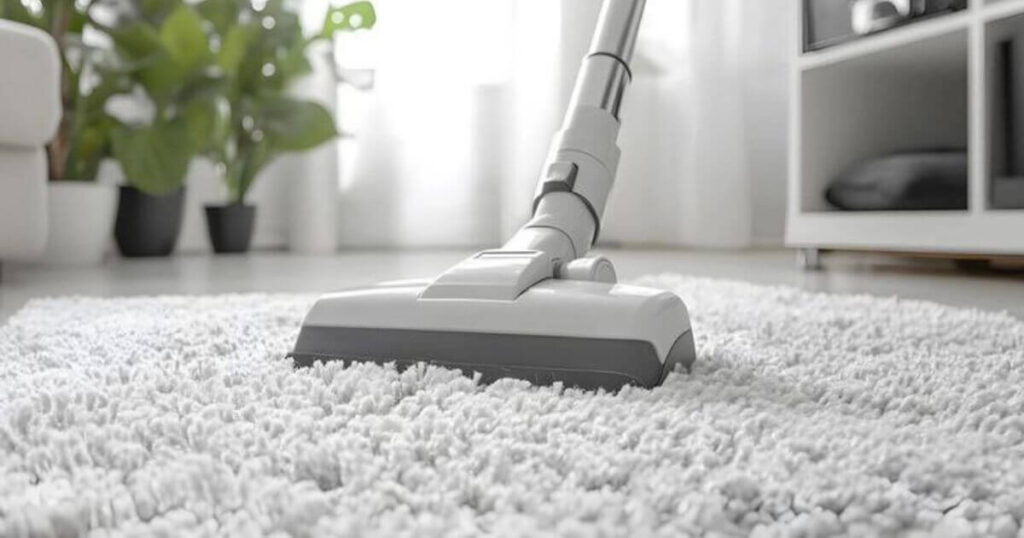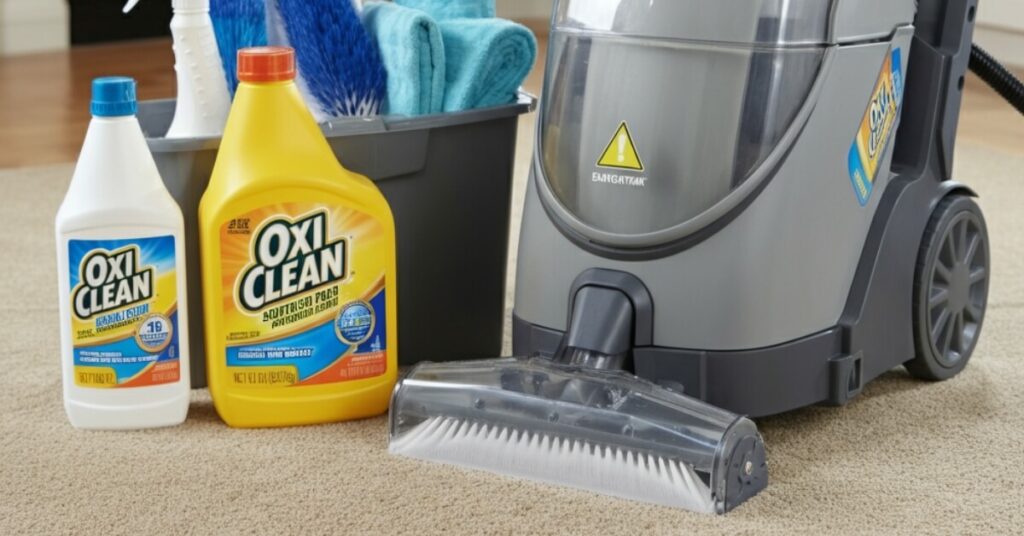As an Amazon Associate, I earn from qualifying purchases.
Carpet steam cleaners are designed to restore and deep clean stained carpets, restoring the life to the carpets. While these machines might seem complicated to some, the main question, How Does a Carpet Steam Cleaner Work, it leads us to wonder whether they actually release pure steam, or if they use another mechanism to clean.
If you are interested in learning the details, expected outcomes, or simply the science behind carpet steam cleaners, this guide is made for you. This guide will clarify the technology used and what outcomes you can achieve with steam carpet cleaning. You will learn not only how these devices eradicate dirt, bacteria, and allergens but also how to determine the need to use these devices around the home.
What Is a Carpet Steam Cleaner?

A carpet steam cleaner is more versatile than its name suggests. The most common method, “hot water extraction,” uses heated water and a cleaning solution to wash carpet fibers. Afterwards, a vacuum removes the dirty water. Unlike manual cleaning or regular vacuuming, this method works wonders. As a result, carpet steam cleaners are a staple in homes and professional cleaning services.
Key Features of a Carpet Steam Cleaner
- Deep Carpet Penetration – Unlike manual vacuums that scrub only the top layer of carpets, steam cleaners eject water deep into the carpet pile.
- Hot Water Power – The majority of carpet steam cleaners heat water between 120°F and 200°F, which is hot enough to kill harmful microorganisms.
- Powerful Extraction – In addition to soaking carpets, steam cleaners remove water, dirt, and cleaning residues almost instantaneously.
How Does a Carpet Steam Cleaner Work?
Curious about what actually happens once you break out the steam cleaner? Let’s take a journey through the cleaning process.
1. Water Heating
All carpet steam cleaners come with a water tank. When filled and turned on, an in-built heating element raises the water temperature to somewhere between 120°F to 220°F. A more advanced steam cleaner may dislodge stubborn debris better as they can achieve higher temperatures.
2. Adding Cleaning Solution (Optional)
At this stage, certain steam cleaners allow you to mix in a cleaning agent. Some stains like coffee, wine, or pet stains respond well to added detergents, but many users prefer cleaning with just water. Not using any chemicals is a major advantage steam cleaners have over other cleaning devices, especially for households with children or pets.
3. Application to Carpet
With the heated liquid in place, the next task is the delivery system. The carpet steam cleaner moves the hot solution (water or water mixed with solution) through nozzles down to the fibers of the carpet. This step saturates the material very well and assists in breaking down hard embedded and stubborn dirt particles that resist standard cleaning.
4. Heat Loosens Dirt, Bacteria, and Stains
Now the interesting part. The combination of heat and moisture not only lifts general dirt; it also works on bacteria, dust mites, allergens, and mold spores that may be hiding in the carpet. Hot water will free particles, weaken sticky residues, and dissolve numerous forms of grime.
5. Extraction and Suction
As the solution breaks up soil and stains, the machine’s vacuum system simultaneously works to extract dirty water, debris, and cleaning agents from the carpet. This is an important part of the process to prevent dirt from being redistributed through the carpet.
The soiled water is transferred to a separate holding tank that you will empty. It is the powerful suction and ability to remove both liquid and grime that sets steam cleaners apart from standard vacuum cleaners, which makes the difference.
6. Drying Phase
The carpet will be damp at the end of the cleaning cycle, and not fully soaked. The remaining moisture will dry within a few hours. Thinner carpets may take less time. Fans, open windows, and HVAC adjustments will further expedite drying time. While the carpet is drying, avoid walking on it to prevent any new dirt from being added.
This procedure works well with steam cleaners, which are very helpful for households looking for thorough and hygienic results.
Read Next: Bissell Little Green Multi-Purpose Portable Carpet Cleaner Review | Is It Worth It?
What Does Steam Cleaning Actually Remove?
With a steam cleaner, the hot water extraction process removes many different kinds of dirt. Some may be invisible, but are still vital for the carpet’s condition and appearance.
- Ground-In Dirt: Deep extraction removes dirt and debris that vacuum brushes cannot reach.
- Hard-to-Remove Stains: Food spills, pet accidents, and even tracked mud are much easier to remove with steam.
- Foul Odors: Hot water goes deep beneath the surface and neutralizes odor-causing bacteria, countering stink better than sprays.
- Allergens and Dust Mites: Allergies are a significant problem for many families, which means there’s a benefit to reducing these triggers.
- Mold and Microbes: While steam cleaning doesn’t take the place of proper mold removal, it helps lower mold spores and some bacteria.
- Pet Dander: More so for homes with pets, the removal of dander helps make the surrounding air much fresher.
Is Steam Cleaning Safe for All Carpets?
There are restrictions when it comes to steam cleaning, as not all carpets deal with moisture, heat, and suction the same way.
- Synthetic Carpets: Carpets made from nylon, polyester, or olefin fibers are steam cleaned without worry. Unlike other types of carpets, these fibers withstand heat and water extraction. Thorough cleaning is possible with no concerns.
- Natural Fibers: Wool, silk, or plant based fiber carpets are delicate and need to be treated carefully. Steam cleaning can be done but only with special precautions. Damage may occur in the form of overheating or water saturation leading to leaving stubborn marks or undesirable shapes.
Pro Tip: Consult your carpet manufacturer’s recommendations before attempting steam cleaning. If in doubt, always spot test the process on a small, hidden area to make sure there’s no adverse reaction.
Weighing the Pros and Cons
No cleaning solution is perfect for every situation, and steam cleaning is no exception. Here’s how to decide if it’s the right approach for your carpets:
Pros
- Thorough Clean: Steam penetrates carpets deeply and removes soil and other contaminants better than vacuums and other carpet cleaning machines.
- Sanitisation: Hot water eliminates most forms of bacteria, mites, and certain viruses, which is beneficial to families with children or people who suffer from allergies.
- Chemical-Free Option: Cleaning with just water makes it safer for pets, babies, or anyone sensitive to cleaning agents.
- Fresher Results: Carpets are left smelling clean. Strong suction removes musty odors, resulting in cleaner carpets.
- Extends Carpet Life: Preserving carpet fibers can be accomplished with the deep removal of debris, dust, and residue.
Cons
- Drying Time: Your carpet can take several hours to dry completely. While damp, the carpet should not be walked on or have furniture placed on it.
- Not for Every Carpet: Some sensitive natural fibers and antique carpets need to be handled with care and may need different cleaning methods.
- Equipment Required: Steam cleaning vacuums require more equipment when compared to regular brooms or vacuums. Purchasing or renting a steam cleaning vacuum is an additional cost.
- Preparation: Moving furniture adds to the workload quite a bit.
- Physical Effort: For larger households, maneuvering a steam cleaner can become physically demanding.
Weigh these factors in the context of your home’s needs. For allergy-prone families, households with pets, or heavily trafficked areas, the deep cleaning power of a steam cleaner is often worth the trade-offs.
Getting the Most Out of Your Steam Cleaner
To maximize the effectiveness of your carpet steam cleaning, consider these practical steps:
- Vacuum First: Remove loose debris and dust so that the steam cleaner can target deep-down dirt.
- Spot Pre-Treat Stains: For best results, use a compatible carpet stain remover on troublesome spots before steam cleaning.
- Don’t Over-Wet: Move slowly but avoid excessive water on any one section. Over-wetting can cause damage or encourage mold growth.
- Ventilate: Use fans, open windows, and crank up the HVAC system to accelerate drying and prevent any musty smells.
- Routine Maintenance: Regular deep cleaning, coupled with good habits like shoe removal and immediate attention to spills, will keep carpets fresh for years.
Final Thoughts

Carpet steam cleaners are invaluable in restoring the carpets, deodorizing them, and improving the overall hygiene of the house. Steam cleaners utilize heated water and powerful suction which removes dirt and bacteria embedded in the carpets and much more. Such methods increase the cleanliness of the home and ensure it is hospitable.
Make sure carpet steaming suits your carpet type, manufacturer guidelines are followed, and proper measures are taken for the carpet to dry adequately.
Weighing advantages and disadvantages will provide clarity on whether a rental, a purchase, a do-it-yourself approach, or a professional call would be the best option. No matter the carpet steam cleaner choice, these are effective in renewing the most active room in the house.
Steam cleaning is not only a task, but it’s also an investment in your home’s health and well-being. Remember, as you progress with the deep cleaning, that the most important part of maintenance is knowing how long does a carpet cleaning take
and when to care for your pristine space.
FAQs About Carpet Steam Cleaning
Here are answers to some of the most frequently asked questions- because a little knowledge can help you get the very best results from your cleaning routine.
1. Is steam cleaning the same as carpet shampooing?
Not exactly. Carpet shampooing uses detergent, a brush, and more water to scrub the fibers, but may leave residues unless rinsed thoroughly. Steam cleaning, in contrast, uses hot water extraction—with or without detergents—and pulls most liquid (and mess) out, resulting in less residue and a quicker drying time.
2. Can I clean with only water?
Yes! A major advantage of steam cleaning is that it’s highly effective even if you use just hot water. No chemicals are required, making it safer for sensitive pets or family members, and better for the environment. That said, for set-in stains, a compatible cleaning solution may help.
3. How often should carpets be steam cleaned?
For average households, once or twice a year does the trick. However, for homes with pets, regular spills, or heightened allergy concerns, consider steam cleaning every three to six months. Spot cleaning in between can also help maintain results.
4. Will steam cleaning get rid of all odors?
In most cases, yes. Because steam cleaning kills bacteria and neutralizes many sources of odor, carpets usually smell much fresher afterward. Stubborn odors—like old pet accidents or deeply saturated stains—may require a repeat cleaning or additional odor-eliminating products.
5. Should I rent or buy a steam cleaner?
If you have a large home or want maximum convenience, owning a machine makes sense. For occasional use, renting is more affordable. Many hardware and home improvement stores offer rental models suitable for most residential use.
As an Amazon Associate, I earn from qualifying purchases.

